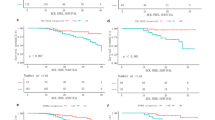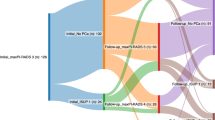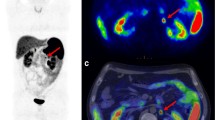Abstract
Objective
To build a CT-based radiomics model to predict the pathological grade of bladder cancer (BCa) preliminarily.
Methods
Patients with surgically resected and pathologically confirmed BCa and who received CT urography (CTU) in our institution from October 2014 to September 2017 were retrospectively enrolled and randomly divided into training and validation groups. After feature extraction, we calculated the linear dependent coefficient between features to eliminate the collinearity. F-test was then used to identify the best features related to pathological grade. The logistic regression method was used to build the prediction model, and diagnostic performance was analyzed by plotting receiver operating characteristic (ROC) curve and calculating area under the curve (AUC), sensitivity, specificity, positive predictive value (PPV), and negative predictive value (NPV).
Results
Out of 145 included patients, 108 constituted the training group and 37 the validation group. The AUC value of the radiomics prediction model to diagnose the pathological grade of BCa was 0.950 (95% confidence interval [CI] 0.912–0.988) in the training group and 0.860 (95% CI 0.742–0.979) in the validation group, respectively. In the validation group, the diagnostic accuracy, sensitivity, specificity, PPV, and NPV were 83.8%, 88.5%, 72.7%, 88.5%, and 72.7%, respectively.
Conclusions
CT-based radiomics model can differentiate high-grade from low-grade BCa with a fairly good diagnostic performance.
Key Points
•CT-based radiomics model can predict the pathological grade of bladder cancer.
•This model has good diagnostic performance to differentiate high-grade and low-grade bladder cancer.
•This preoperative and non-invasive prediction method might become an important addition to biopsy.



Similar content being viewed by others
Abbreviations
- ADC:
-
Apparent diffusion coefficient
- AUC:
-
Area under the curve
- BCa:
-
Bladder cancer
- CI:
-
Confidence interval
- CT:
-
Computed tomography
- CTTA:
-
CT texture analysis
- CTU:
-
CT urography
- DWI:
-
Diffusion-weighted imaging.
- GLCM:
-
Gray-level co-occurrence matrix
- GLDM:
-
Gray-level dependence matrix
- GLRLM:
-
Gray-level run-length matrix
- GLSZM:
-
Gray-level size zone matrix
- ICC:
-
Interclass correlation coefficients
- MIBC:
-
Muscle-invasive BCa
- NMIBC:
-
Non-muscle-invasive BCa
- NPV:
-
Negative predictive value
- PPV:
-
Positive predictive value
- ROC:
-
Receiver operating characteristic
- ROI:
-
Region of interest
- T2WI:
-
T2-weighted imaging
- TURBT:
-
Transurethral resection of bladder tumor
References
Antoni S, Ferlay J, Soerjomataram I, Znaor A, Jemal A, Bray F (2017) Bladder cancer incidence and mortality: a global overview and recent trends. Eur Urol 71:96–108
Bray F, Ferlay J, Soerjomataram I, Siegel RL, Torre LA, Jemal A (2018) Global cancer statistics 2018: GLOBOCAN estimates of incidence and mortality worldwide for 36 cancers in 185 countries. CA Cancer J Clin 68:394–424
Roupret M, Babjuk M, Comperat E et al (2018) European Association of Urology guidelines on upper urinary tract urothelial carcinoma: 2017 update. Eur Urol 73:111–122
Humphrey PA, Moch H, Cubilla AL, Ulbright TM, Reuter VE (2016) The 2016 WHO classification of tumours of the urinary system and male genital organs-part B: prostate and bladder tumours. Eur Urol 70:106–119
Fiuk JV, Schwartz BF (2016) Upper tract urothelial carcinoma: paradigm shift towards nephron sparing management. World J Nephrol 5:158–165
Reis LO, Taheri D, Chaux A et al (2016) Significance of a minor high-grade component in a low-grade noninvasive papillary urothelial carcinoma of bladder. Hum Pathol 47:20–25
Klaassen Z, Kamat AM, Kassouf W et al (2018) Treatment strategy for newly diagnosed T1 high-grade bladder urothelial carcinoma: new insights and updated recommendations. Eur Urol 74:597–608
Palou J, Sylvester RJ, Faba OR et al (2012) Female gender and carcinoma in situ in the prostatic urethra are prognostic factors for recurrence, progression, and disease-specific mortality in T1G3 bladder cancer patients treated with Bacillus Calmette-Guerin. Eur Urol 62:118–125
Leblanc B, Duclos AJ, Benard F et al (1999) Long-term followup of initial Ta grade 1 transitional cell carcinoma of the bladder. J Urol 162:1946–1950
Gudjonsson S, Adell L, Merdasa F et al (2009) Should all patients with non-muscle-invasive bladder cancer receive early Intravesical chemotherapy after transurethral resection? The results of a prospective randomised multicentre study. Eur Urol 55:773–780
Babjuk M, Bohle A, Burger M et al (2017) EAU guidelines on non-muscle-invasive urothelial carcinoma of the bladder: update 2016. Eur Urol 71:447–461
Hansel DE, Amin MB, Comperat E et al (2013) A contemporary update on pathology standards for bladder cancer: transurethral resection and radical cystectomy specimens. Eur Urol 63:321–332
Zhang GM, Sun H, Shi B, Jin ZY, Xue HD (2017) Quantitative CT texture analysis for evaluating histologic grade of urothelial carcinoma. Abdom Radiol (NY) 42:561–568
Gillies RJ, Kinahan PE, Hricak H (2016) Radiomics: images are more than pictures, they are data. Radiology 278:563–577
Lambin P, Rios-Velazquez E, Leijenaar R et al (2012) Radiomics: extracting more information from medical images using advanced feature analysis. Eur J Cancer 48:441–446
Liu Z, Zhang XY, Shi YJ et al (2017) Radiomics analysis for evaluation of pathological complete response to neoadjuvant chemoradiotherapy in locally advanced rectal cancer. Clin Cancer Res 23:7253–7262
Barchetti G, Simone G, Ceravolo I et al (2019) Multiparametric MRI of the bladder: inter-observer agreement and accuracy with the Vesical Imaging-Reporting and Data System (VI-RADS) at a single reference center. Eur Radiol 29:5498–5506
Xu S, Yao Q, Liu G et al (2019) Combining DWI radiomics features with transurethral resection promotes the differentiation between muscle-invasive bladder cancer and non-muscle-invasive bladder cancer. Eur Radiol. https://doi.org/10.1007/s00330-019-06484-2
Wang F, Chen HG, Zhang RY et al (2019) Diffusion kurtosis imaging to assess correlations with clinicopathologic factors for bladder cancer: a comparison between the multi-b value method and the tensor method. Eur Radiol 29:4447–4455
Zhang X, Xu XP, Tian Q et al (2017) Radiomics assessment of bladder cancer grade using texture features from diffusion-weighted imaging. J Magn Reson Imaging 46:1281–1288
Wang H, Hu D, Yao H et al (2019) Radiomics analysis of multiparametric MRI for the preoperative evaluation of pathological grade in bladder cancer tumors. Eur Radiol. https://doi.org/10.1007/s00330-019-06222-8
Garapati SS, Hadjiiski L, Cha KH et al (2017) Urinary bladder cancer staging in CT urography using machine learning. Med Phys 44:5814–5823
Cha KH, Hadjiiski Ph DL, Cohan Md RH et al (2019) Diagnostic accuracy of CT for prediction of bladder cancer treatment response with and without computerized decision support. Acad Radiol 26:1137–1145
Wu S, Zheng J, Li Y et al (2017) A radiomics nomogram for the preoperative prediction of lymph node metastasis in bladder cancer. Clin Cancer Res 23:6904–6911
Mammen S, Krishna S, Quon M et al (2018) Diagnostic accuracy of qualitative and quantitative computed tomography analysis for diagnosis of pathological grade and stage in upper tract urothelial cell carcinoma. J Comput Assist Tomogr 42:204–210
Lin P, Wen DY, Chen L et al (2020) A radiogenomics signature for predicting the clinical outcome of bladder urothelial carcinoma. Eur Radiol 30:547–557
Cowan NC (2012) CT urography for hematuria. Nat Rev Urol 9:218–226
van Griethuysen JJM, Fedorov A, Parmar C et al (2017) Computational radiomics system to decode the radiographic phenotype. Cancer Res 77:e104–e107
Meyer M, Ronald J, Vernuccio F et al (2019) Reproducibility of CT radiomic features within the same patient: influence of radiation dose and CT reconstruction settings. Radiology 293:583–591
Wakai K, Utsumi T, Yoneda K et al (2018) Development and external validation of a nomogram to predict high-grade papillary bladder cancer before first-time transurethral resection of the bladder tumor. Int J Clin Oncol 23:957–964
Morera DS, Lahorewala SS, Belew D et al (2019) Clinical parameters outperform molecular subtypes for predicting outcome in bladder cancer: results from multiple cohorts including TCGA. J Urol. https://doi.org/10.1097/JU.0000000000000351:101097JU0000000000000351
Funding
This study has received funding from the National Natural Science Foundation of China (Grant No. 81901742), the Natural Science Foundation of Beijing Municipality (Grant No. 7192176), the Clinical and Translational Research Project of Chinese Academy of Medical Sciences (Grant No. 2019XK320028), the National Natural Science Foundation of China (Grant No. 91859119), and the National Public Welfare Basic Scientific Research Project of Chinese Academy of Medical Sciences (Grant Nos. 2018PT32003 and 2019PT320008).
Author information
Authors and Affiliations
Corresponding authors
Ethics declarations
Guarantor
The scientific guarantor of this publication is Hao Sun.
Conflict of interest
The authors of this manuscript declare relationships with the following company: Deepwise Inc. Lun Zhao, Li Mao, and Xiuli Li are employees of Deepwise Inc., which contributed to the development of radiomics models described in the study.
Statistics and biometry
No complex statistical methods were necessary for this paper.
Informed consent
Written informed consent was waived by the Institutional Review Board.
Ethical approval
Institutional Review Board approval was obtained.
Methodology
• Retrospective
• Diagnostic or prognostic study
• Performed at one institution
Additional information
Publisher’s note
Springer Nature remains neutral with regard to jurisdictional claims in published maps and institutional affiliations.
Hao Sun is the first corresponding author and Zhengyu Jin is the second corresponding author of this work.
Rights and permissions
About this article
Cite this article
Zhang, G., Xu, L., Zhao, L. et al. CT-based radiomics to predict the pathological grade of bladder cancer. Eur Radiol 30, 6749–6756 (2020). https://doi.org/10.1007/s00330-020-06893-8
Received:
Revised:
Accepted:
Published:
Issue Date:
DOI: https://doi.org/10.1007/s00330-020-06893-8




